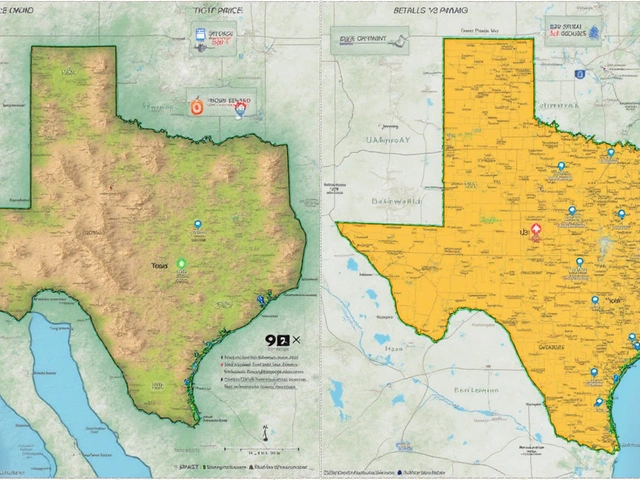In challenging economic times, certain businesses feel the pressure more than others, particularly those tied to commercial properties. When a recession looms, it's crucial to know which sectors might suffer most and why. Whether evaluating historical events or anticipating future trends, the goal is to identify the vulnerable points in the commercial property marketplace.
These downturns can starkly expose the fragility of some industries, while others might find unexpected opportunities to adapt and grow. By examining real-world case studies and industry dynamics, one can learn valuable lessons about resilience and strategic planning. This exploration is not merely academic—it’s an essential guide for navigating uncertain economic waters.
- Understanding Recession Impact
- Industry-Specific Struggles
- Adapting to Market Shifts
- Historical Trends and Case Studies
- Strategies for Resilience
Understanding Recession Impact
The onset of a recession can feel abrupt, yet the ripples reach far and wide, particularly through commercial property markets. The impact isn’t just about immediate economic contraction; it's about the cascade of effects that challenge businesses and reshape market dynamics. At the outset, firms reliant on commercial real estate find themselves grappling with sudden declines in consumer confidence and spending. This shift forces many companies to downscale their operations, and in severe cases, shutter underperforming locations. As businesses recalibrate, vacancies can rise sharply, putting downward pressure on rental prices.
Such turmoil can leave landlords scrambling to hold onto tenants, often resorting to desperate measures like renegotiating contracts or offering significant rent reductions. Even as property owners face such pressures, banks and financial institutions tighten lending policies, making it harder for businesses to secure the capital necessary to sustain their operations or expand. The effect is a bidirectional squeeze—rising operational costs and shrinking revenue streams—which many businesses find difficult to manage.
Historical recessions have shown us that certain industries are more resilient than others. For example, the tech sector may better weather recessions due to its versatility and reliance on digital offerings, while brick-and-mortar retail often struggles as consumers tighten their belts.
"The darkness of economic downturns often reveals the cracks in business models," said renowned economist Jane Foster, highlighting how recessions not only challenge finances but also operational frameworks.It's fascinating how some restaurants become ghost kitchens or pivot to exclusive delivery services, adapting creatively to the circumstances at hand.
There’s also a predictable, yet sometimes unexpected effect on urban landscapes. High-demand urban areas might see a sudden dip in property values, both providing challenges and opportunities. Yet, the real question is not just who survives, but how businesses can pivot to harness these changes as drivers for innovation. Real estate developers, too, recalibrate their strategies during such downturns, rethinking project scopes, timelines, and tenant mix to weather the financial storm.
| Year | Average Rental Decline (%) |
|---|---|
| 2008 | 10.2 |
| 2020 | 7.5 |
The data above reflects how recessions can significantly depress commercial rent prices, pushing landlords and businesses into a cycle of survival and adaptation. In such times, understanding these intricate impacts on the market is more than an academic exercise; it's a crucial part of strategizing for survival and success. As we continue to grapple with these truths, it becomes clear that knowledge and flexibility are invaluable assets. They are as crucial as bricks and steel in the foundations of commercial real estate.
Industry-Specific Struggles
When an economic recession strikes, not all industries experience the downturn equally. The commercial property sector, deeply intertwined with various economic activities, sees nuanced impacts across different businesses. Retail, for example, often faces significant challenges during a recession. As consumer spending shrinks, brick-and-mortar stores struggle to meet rent demands, leading to increased vacancies in shopping centers and malls. This trend isn’t just a modern phenomenon; historically, every major recession has seen a decline in retail occupancy rates.
On the flip side, we see tech companies and creative industries sometimes occupying the space left open by retail, thanks to their flexibility and lower reliance on foot traffic. These sectors highlight a growing shift in the economy that values digital interaction over physical presence, but they too face their struggles. Funding can become scarce, and growth projects are often delayed or shelved until economic conditions stabilize. This tightening of investment affects their capacity to expand office spaces, directly impacting commercial property dynamics.
Service industries such as restaurants and bars also lash out under the weight of a recession. The reality of decreased disposable income means fewer customers dining out, which can mean the difference between staying open and closing doors for many businesses. This gets reflected in property leases and rental agreements, as building owners themselves face the dilemma of maintaining occupancy at the expense of losing revenue. According to a study by the National Bureau of Economic Research, around 30% of small restaurants fail within the first year of a recession.
"Even in times of economic hardship, those who can adapt their business model are more likely to survive," says Jason Wallace, an economist specializing in urban development.
As businesses adapt, some industries find creative ways to overcome these hurdles. Co-working spaces have gained popularity, offering flexible leasing options that appeal to startups and freelancers looking for cost-effective working environments. This shift towards more adaptable office solutions allows tenants to downsize or upsize quickly based on their needs and provides landlords with a steady if varied, source of income. However, this results in a volatile market for commercial properties, where demand and supply can fluctuate dramatically.
A fascinating part of this complex puzzle is the impact on logistics and warehousing. While traditional retail suffers, e-commerce often sees an uptick during economic downturns, driven by competitive pricing and convenience. This creates a counter-pressure on logistics companies to expand their warehouse footprints to meet rising online order demands. The logistics sector’s resilience demonstrates a compelling side of economic downturns; where decline afflicts some, others see opportunity, prompting a reshaping of the commercial property landscape in unexpected ways.
| Industry | Impact Level | Typical Changes |
|---|---|---|
| Retail | High | Increased vacancies, lower rents |
| Tech | Moderate | Paused expansions, flexible leases |
| Restaurants | High | Closures, renegotiated leases |
| Logistics | Low | Expansion in e-commerce warehousing |
Thus, navigating these industry struggles requires a nuanced understanding of market dynamics, an appreciation for adaptability, and the foresight to anticipate future trends. It's a landscape where survival is often a testament to innovation, flexibility, and strategic planning.

Adapting to Market Shifts
Navigating through a recession requires businesses to be malleable and proactive, particularly for those linked to the commercial property market. In turbulent times, these businesses must consider evolving their strategies to stay afloat. Twenty years ago, the real estate landscape looked different, with many businesses depending heavily on brick-and-mortar establishments without much flexibility. However, recent trends show a shift toward adaptable strategies that can cushion against downturns. These shifts often involve diversifying portfolios, incorporating technology, and embracing innovative approaches to client engagement. Let's delve deeper into how businesses can adapt to these market transformations.
A key strategy for this adaptation is diversifying revenue streams. Many recession-hit businesses realized that relying on a single source of income can be risky. Whether it’s property owners looking into co-working spaces or retailers opening online shops, expanding income avenues can mitigate losses. This approach not only stabilizes cash flow during uncertain times but also opens new opportunities. For instance, the rise of e-commerce during economic slumps has prompted traditional retailers to develop digital platforms, reaching new markets and enhancing resilience. Another trend is the use of shared spaces. Businesses can capitalize on the increasing demand for flexible, communal work environments, which can attract new tenants even during a downturn.
Integrating technology is another pivotal adjustment. With technology constantly evolving, businesses that quickly adopt new systems often find themselves better equipped to ride out economic challenges. Automation, for instance, can optimize operational efficiency, reduce costs, and improve customer service, giving those who embrace it a significant competitive edge. Technologies like virtual tours for real estate properties and AI-driven analytics tools for market predictions exemplify how firms are using tech advancements to stay relevant. Given the global pandemic's push toward digitalization, this trend isn’t just a response mechanism but a long-term strategy for success.
"Adaptation is not a choice anymore; it’s a requirement," says Michael Potts, CEO of Market Strategies Co., highlighting the necessity of evolving with the times in a rapidly changing economic landscape.
An emphasis on sustainability and eco-friendliness is another emerging adaptation strategy. With climate change issues coming to the fore, adopting sustainable practices can not only reduce costs in the long run but also attract the growing number of environmentally conscious consumers. Simple implementations like maximizing energy efficiency across properties or utilizing renewable energy sources can go a long way. These initiatives not only improve brand image but also enhance occupant satisfaction, keeping spaces leased even when the economic environment sours.
One crucial element for businesses is maintaining strong relationships with stakeholders. Collaboration with partners, investors, and customers is vital in weathering economic storms. Consistent communication and a shared understanding of goals can lead to more strategic decisions. This includes renegotiating lease terms with tenants to ensure mutual benefits during hard times. A proactive approach in maintaining relationships generally leads to creative solutions that address the challenges of a recession and strengthen business ties.
Let’s take a look at how different sectors have adapted historically through data:
| Industry | Adaptation Strategy | Success Rate |
|---|---|---|
| Retail | Online Expansion | 75% |
| Hospitality | Shared Space Utilization | 68% |
| Commercial Real Estate | Co-Working Space Development | 80% |
As explored, businesses can use these various strategies to adapt and thrive during economic downturns. While no one-size-fits-all solution exists, combining these approaches can significantly increase a business's chances of survival and success. The ability to shift gears and redefine business models, focusing on flexibility, technology, and sustainable practices, ensures readiness when the next economic wave hits. The concept of adaptation is about more than survival; it’s about positioning oneself for long-term growth, irrespective of economic conditions.
Historical Trends and Case Studies
Recessions have had a profound influence on the commercial property sector throughout history. To understand the impact, it’s worth delving into past economic downturns to see how they shaped various industries. One standout example is the Great Recession of 2007-2009, which devastated the real estate market, leading to a significant drop in property values. This period illustrated how intertwined the financial markets and real estate sectors are, causing ripples that were felt globally. During this time, many businesses reliant on retail spaces, such as large department stores, faced declining sales and foot traffic, forcing closures and vacancies in shopping malls across nations. This contraction wasn't just a short-term issue; it reshaped consumer habits and business models, nudging both towards online platforms, a shift that is still relevant today.
A closer look at the 1990s recession reveals another layer of the economic impact on commercial property. Following the savings and loan crisis, commercial real estate saw a sharp decline, with overbuilt office spaces remaining empty for significant periods. As financing dried up, developers halted projects mid-construction, leaving skeletons that haunted cityscapes. This highlighted the critical role financing plays in the industry and the risks of over-leveraging. Additionally, innovations such as real estate investment trusts (REITs) emerged as a response to these pressures, offering new avenues for investment and ownership that have since remained an industry standard.
According to Urban Land Institute, "The lessons learned during these downturns continue to inform how we manage property cycles and prepare for inevitable future corrections."
Crisis can sometimes serve as a springboard for innovation. During the dot-com bubble burst in the early 2000s, tech companies with expansive office needs suddenly found themselves shrinking or collapsing. Yet, this period ushered in a boom for business models that offered more flexible office solutions, leading to the popularity of co-working spaces. This trend set the stage for companies like WeWork. It exemplifies how recessions can spur creative solutions that redefine industry standards and shape market dynamics long after the economic storm has passed. The cycle of boom and bust in the commercial property world teaches resilience and adaptation, with industry stakeholders learning to balance optimism with cautious planning. As history has shown, those who adapt with flexible strategies tend to thrive in the long run, even during unavoidable downturns.
A quick comparison can be made with the COVID-19 induced recession, which delivered a new set of challenges and opportunities. Symptoms of economic trouble manifested differently; retail tenancies struggled, yet industrial properties, such as warehouses, grew in value due to the e-commerce boom. This transformation was data-driven, reflecting the swift shift to online retail methodologies. Historical patterns suggest that industries often dubbed "recession-proof," continuously evolve, creating demand for particular property types while rendering others obsolete. These examples underscore the importance of analyzing historical recessions to predict how current and future downturns might unfold, helping industry players make informed decisions amidst uncertainty. Economic downturn stories remind us that while cycles repeat, each event is unique in its challenges and lessons.

Strategies for Resilience
Building resilience in the face of economic downturns requires a deep understanding of market dynamics, clear strategic planning, and a willingness to adapt. The unpredictable nature of a recession means that businesses within the commercial property sector must be agile enough to withstand shocks while seizing opportunities that arise. One of the key strategies here is diversification. Just as a well-balanced investment portfolio tends to weather market storms better, diversifying a business's income streams can buffer against inconsistent revenue flows during a recession. This could mean expanding into different types of commercial properties or offering complementary services that enhance the value proposition of the existing business.
Preemptive cost management is another critical element. Before a recession even hits, businesses should aim to streamline operations and review all unnecessary expenses. Lean management principles can be valuable in this regard, as they encourage maintaining efficiency without sacrificing service quality. By evaluating fixed and variable costs, businesses can identify areas where savings may be possible, ultimately preserving vital resources. Another key factor is maintaining liquidity, which gives businesses the ability to invest strategically, should unique opportunities arise. According to a study by the National Bureau of Economic Research, companies with strong liquidity are better positioned to capitalize on distressed assets or underpriced opportunities during a recession.
Leveraging Technology and Data
There's also a technological dimension to resilience. The intelligent use of technology can enhance operational efficiency and provide competitive advantages. Data analytics, for instance, can offer insights into market trends and consumer behaviors, allowing businesses in the commercial property sector to make informed decisions amid uncertainty. By investing in tech infrastructures such as Customer Relationship Management (CRM) systems or building automation, businesses can optimize processes and improve customer experiences. One might consider exploring PropTech trends—technology designed specifically for the real estate industry—which can open new doors to efficiency and client engagement.
In challenging times, strategic partnerships play an essential role. Establishing strong, cooperative relationships with stakeholders—such as tenants, suppliers, or service providers—can create a network of mutual support. Flexible lease arrangements, for instance, might aid tenants facing temporary hardships, enhancing customer loyalty and payment continuity. Additionally, tapping into government or financial programs available during downturns can offer much-needed support. A notable example comes from the Financial Conduct Authority report, illustrating how businesses that proactively sought financial guidance during past downturns often emerged more resilient.
"Success in any challenge doesn’t come simply from new ideas but from cultivating an organization's ability to change, unlock new tactics, and shift paradigms," Pete Carroll apt remarks encapsulate the essence of how to navigate these turbulent times.
Ultimately, resilience during a recession is not just about surviving but about thriving amid adversity. By employing diversified strategies, maintaining liquidity, leveraging technology, and nurturing robust relationships, businesses can not only weather economic storms but also emerge stronger and ready to capitalize on post-recession recovery.





